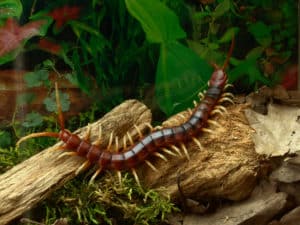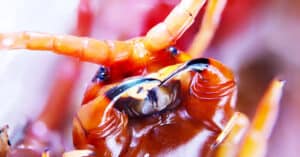You are bound to cross paths with with one type of centipede or another at any given time, since they inhabit most areas of the world. Defying their common name, no species of centipede only has 100 legs, but will have more or less. The number of leg pairs they have is always odd–just one interesting fact about this animal. A variety of species of centipedes exist, some with flashing colors, and others small in size. It is easy to confuse a centipede for an insect. Centipedes are arthropods and in the subphylum Myriapoda. They belong to the class of Chilopoda, which contains over 3,000 species.
We have compiled 8 different centipede species, and fascinating things to know about each one. Most centipedes are known for their long bodies and a large number of legs, but some species will differ. Living mostly in moist dark habitats, some species can even find their way into your home. Let’s go over 8 of the most fascinating centipede species living across the world.
1. Feather Tail Centipede (Alipes grandidieri)
The feather tail centipede is a species of giant centipede, known for its feather-like legs at the end of its tail. Native to Africa, they live in the regions of Kenya, Tanzania, and Uganda. It’s a type of centipede that is large in size like other giant centipedes, averaging around 4 to 6 inches long. Its body is black and segmented, with bright orange legs. Its back legs are brightly colored and look like wings. The feather tail centipede is one of the only species with this type of wing on its legs, but it cannot fly.
When disturbed this species will shake its tail and create a hissing sound, similar to a venomous snake. Their sting is extremely painful and can lead to a fever and swelling. Still, they are not deadly and are kept as a pet for their colorful winged legs. Roaches, spiders, and insects are what they feed on, occasionally finding their way into homes within their native range. While not the largest of giant centipede species, they are one of the most elegant.
2. House Centipede (Scutigera coleoptrata)

The house centipede is one of the most common types
©zaidi razak/Shutterstock.com
As one of the oddest looking species of centipede, they are also the most common. House centipedes are small and thin. Their legs are long and surround their body, making them look bigger. When measured with their legs, they will only reach around 3 to 4 inches. They are yellowish gray, covered in dark stripes.
House centipedes are insectivores and are attracted to the insects in your homes. Active mostly at night, you may find this type of centipede running across your living room looking for prey. This centipede is one of the most fearsome-looking arthropods that can be found in your home but are beneficial in fending off other pests. Unwanted creatures like bed bugs, fleas, and spiders will be terminated if they cross paths with this species.
Usually harmless, this centipede is capable of biting. Bites are rare but they will do so when provoked. Itching, nausea, and swelling are some of the symptoms, but will only happen on rare occasions. Believed to be native to the Mediterranean region, they have managed to make their home in houses across the globe. Common in the U.S, they are often seen as natural pest control for homes.
3. Amazonian Giant Centipede (Scolopendra gigantea)
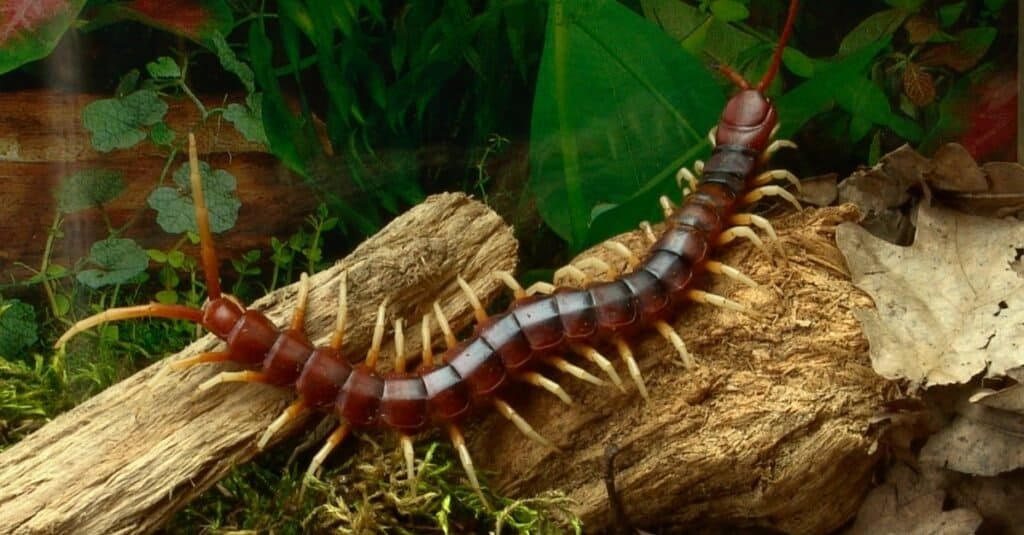
The Amazonian giant centipede can grow larger than 1 foot long!
©skifbook/Shutterstock.com
The Amazonian giant centipede, also known as the Peruvian giant yellow-leg centipede is the largest species of centipede in the world. This giant averages around 10 inches, but is capable of growing larger than 1 ft. On average they have around 21 to 23 pairs of legs. Their body is maroon red, held up by large yellow legs.
This type of centipede is native to the Amazonian jungles of South America but is kept as a pet around the globe. They may be invasive in Mexico, Honduras, Puerto Rico, and other tropical areas. Its size and the venomous bite are why many fear this species. They are carnivorous, feeding on smaller animals like mice, birds, bats, lizards, scorpions, tarantulas, and insects. Like other species, a bite from this centipede is extremely painful, but not deadly. Only one death from this species has been documented. Their large sized fangs and bright colors make them a unique pet to keep.
4. Tiger Centipede (Scolopendra polymorhpa)
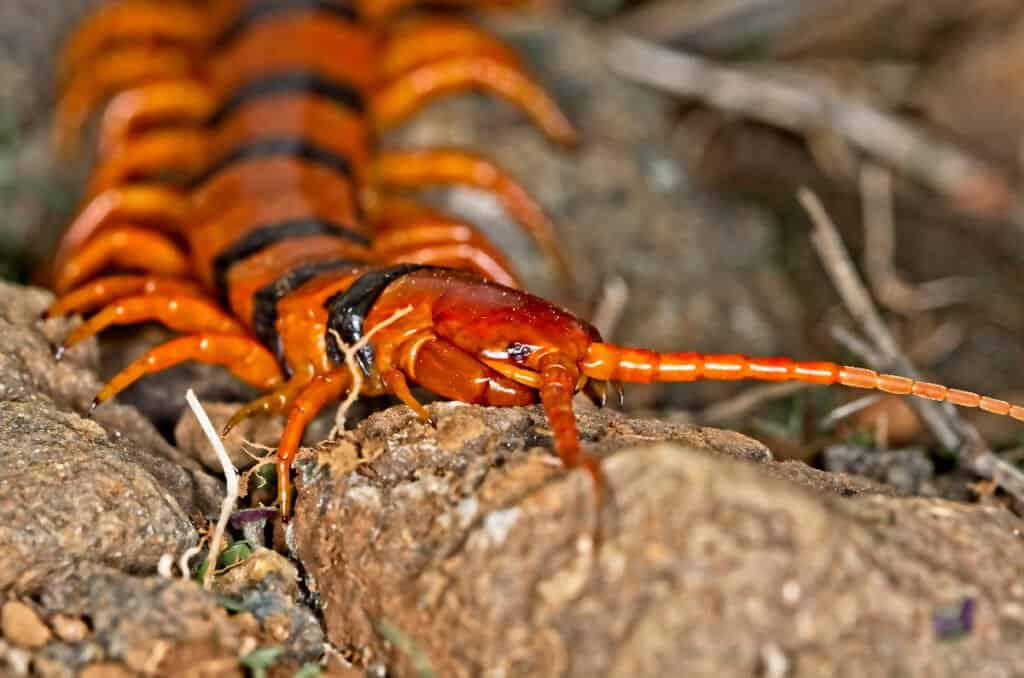
©ananth-tp/Shutterstock.com
In deserts habitats within the United States roams the tiger centipede. They can be found in the South-Western United States and Northern Mexico, living in desert-like habitats. Named for their dark bands going down their dorsal plates, they can come in multiple colors. Tan or orange is the body color, with a brown, red, or orangish head. Their legs are yellow, and certain centipedes of this species in California have blue coloring like the Tanzanian Blue RIng centipede.
This desert centipede is large enough to produce a sting that is painful and highly venomous. Like the house centipede, this species may find its way into your home in areas it lives in, probably looking for food. They are nocturnal and are attracted to food like insects or small animals. Under debris and in moist dark areas is where they will hide out during the day, waiting to hunt at night.
5. Aquatic Centipede (Scolopendra cataracta)
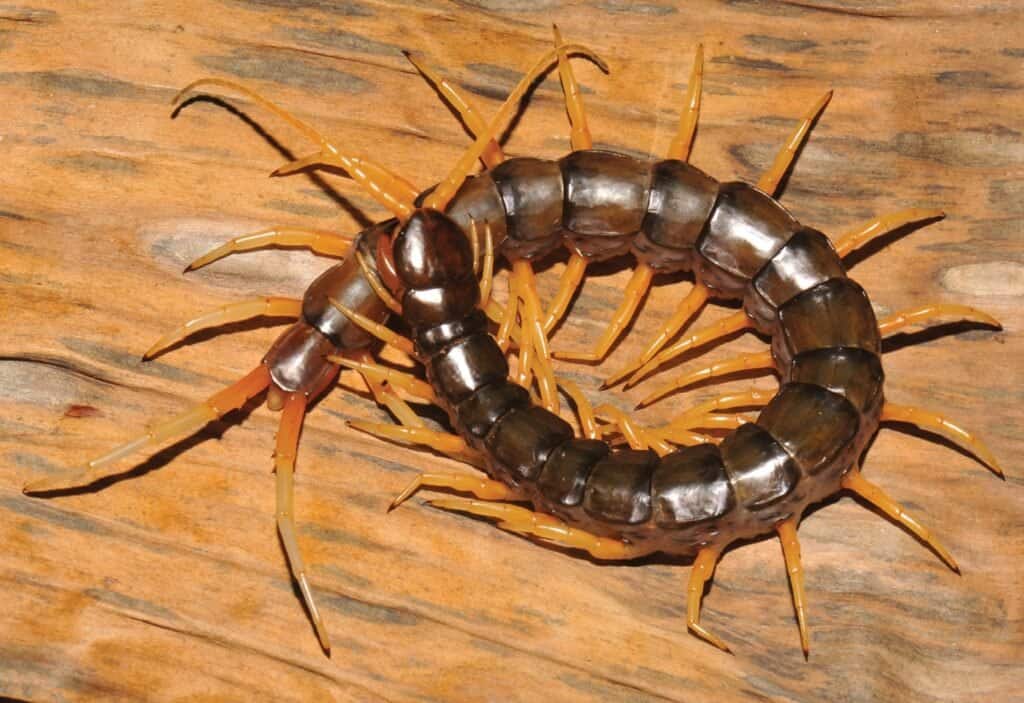
©Warut Siriwut, Gregory D. Edgecombe, Chirasak Sutcharit, Piyoros Tongkerd, Somsak Panha; crop by EdChem / Creative Commons – License
The aquatic centipede is a species of giant centipede found in Thailand, Laos, and Vietnam. They are capable of growing up to 7 inches and have a greenish-black coloring. Plenty of centipede species can swim, and the aquatic centipede relies on water in its habitat to survive. At night they will hunt and swim in water with eel-like movement. They also use water to escape from natural predators.
Other Scolopendra species live in dry habitats, unlike the aquatic centipede which shows amphibious traits. Their body is hydrophobic and helps water roll off it when leaving the water. This species is a strong swimmer and swims through the water like a fish. Like other centipede species, they are also venomous and are capable of delivering a powerful sting.
6. Giant Red-Headed Centipede (Scolopendra heros)

©Creeping Things/Shutterstock.com
In northern Mexico and the Southern States of the U.S, the Giant red-headed centipede is a species many fear. This species on average is around 6.5 inches but can reach 8 inches long. One color variant of this species is a black body with a bright redhead. They have around 23 legs. Other color variants exist like a black head and red body.
Other names of this centipede include:
- Giant desert centipede
- Giant Sonoran centipede
- Texas redheaded centipede
The Giant red-headed centipede is the largest in North America. They are nocturnal, resting in dark damp hiding places. Seeing this species can be quite a surprise due to its large size and vibrant color. Their presence can be unknown due to their secretive nature, but they may find themselves in your home searching for food. Frogs, lizards, rodents, and insects are what they feed on. Their bite is venomous, helping it neutralize small predators and is painful for humans.
7. Tanzanian Blue Ring Centipede (Ethmostigmus rubripes)
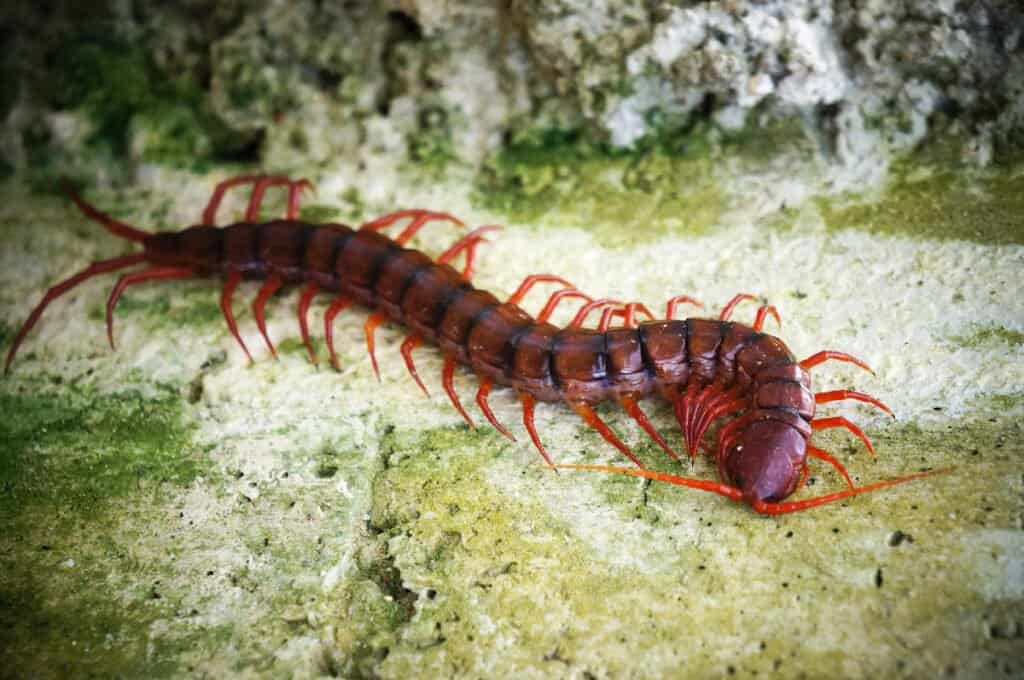
©attem/Shutterstock.com
Tanzanian blue ring centipedes are known for and named after their blue coloring. Their body is Blue-green, with light blue coloring on their legs. In Tanzania, The Congo, and Sudan they can be found in savanna habitats. They are a burrowing species and will bury themselves in sandy soils. Under rocks, logs and other dark places are where they prefer to live, but they may venture into other areas searching for food.
Small insects and earthworms are what this species feeds on. They are not the largest of centipede species but can grow up to 7 inches. This centipede is also kept as a pet but is a rare species to find in captivity. They need sandy soil in their enclosure, unlike other centipedes which need a tropical habitat. Their legs, body, and antenna are coated in a nice blue tint, making them stand out from other species of centipedes.
8. Hoffman’s dwarf centipede (Nannarrup hoffmani)
What makes the Hoffmans dwarf centipede fascinating is not only its location but also its small size. In 2002 this species was discovered in New York City in central park. For over a century no new species were discovered in the central park until this centipede came along. They are named after Dr. Richard L. Hoffman, who helped discover the species. This species of centipede is the smallest in the world, only reaching 10mm long.
This small centipede has around 82 legs. In Central Park, they are found amongst leaf litter in soil and around other natural debris. Even though they are tiny this centipede still has many of the other common traits found in other species. They are venomous and ravenous hunters. Feeding mostly on small millipedes, they will hunt any small invertebrate they can find.
With the 3,000 species of centipedes in the world, scientists believe there to be at least 8,000 total species, some undiscovered. The Hoffman’s dwarf centipede is just one example of the new species to be discovered as time goes on.
Up Next:
- The 10 Biggest Centipedes in the World!
- Are Centipedes Poisonous or Dangerous?
- Your Skin Will Crawl When You See These 10 Bugs That Look Like Centipedes
The photo featured at the top of this post is © SAYAN CHAONAMON/Shutterstock.com
Thank you for reading! Have some feedback for us? Contact the AZ Animals editorial team.




